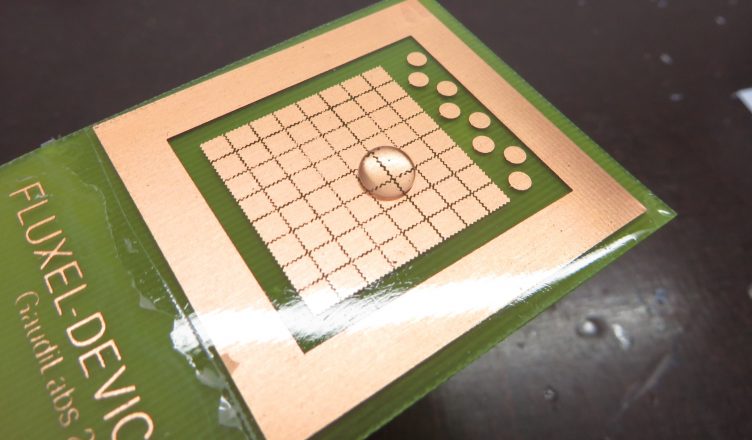To use printed circuit board technology (PCB) to produce the electrode array for electro wetting devices allows for low cost and easy reproducible designs. For the electro wetting effect an electrical separation (dielectric) and hydrophobic surface is required on top of the electrodes. As the PCB electrodes have a standard thickness of 35um in standard process the uneven surface has to be compensated. As describes in scientific literature such as “Fast Fabricating Electro-wetting Platform to Implement Large Droplet Manipulation” by Yiyan Li et all, a foil cover with special coating on top of the electrodes can be used. This presents some important practical advantages:
- complete separation of liquids from electrodes and device
- compensation of surface structure (foil stretched over electrodes)
- easy application of hydrophobic coting
- disposable liquid carrier
- easy handling
To find the right combination of foil and coating material different substrates and coatings have been tested.
Following the standard formula for electro-wetting effect, different factors need to be considered:
cos Ov = cos O0 + ((e e0) / (2 y t) ) V2
- Total voltage applied to the electrodes (isolation volatage)
- Dielectric Constant
- Thickness of Dielectric
For practical reasons the following criteria are imporant:
- Rigidness
- Adhesiveness
- Temperature resistance (for coating)
- Compatibility with coating
- Price
- Availablility
The following foil materials were evaluated:
- Polyethylenterephthalat (PET) – eg. pet bottles, some laser overhead foils
- Polycarbonat (PC) –
- Polyamide (PA) – Dielectric Constant 2.5-2.6
- Polypropylen (PP) – eg. foils for thermoforming – Dielectric Constant 2.2
- Polyvinylidenfluorid (PVDF )
- Polytetrafluorethylen (PTFE) – eg Teflon – Dielectric Constant 1.9 – 2 – 2.1
- Polyetheretherketon (PEEK)
- Ethylene Tetrafluoroethylene (ETFE)
- Polyethylen (PE /NDPE) – saran wrap – Dielectric Constant 2.25
- Polyethylen HDPE
- Polyethylen MDPE
- PDMS – eg casting silicone for microfluidic devices – Dielectric Constant 2.3-2.8
An important constraint on the availability of the materials is the required thickness:
thickness vs. required drive voltage : 0.5um (30V) – 3um (100V) – 7um (125V) – 10um (200V)
Most foil materials are available in thickness > 12um
Thickness of 5um would be desirable for electrowetting as the driving force would be much increased or the driving voltage could be reduced (<120V).
Also the smoothness of the foild surface proofed to be important. This being somewhat difficult to specify
“In this guide the term smooth surface refers to a surface with an approximately random height distribution and a maximum height (Sz) of less than 50 nm. ” Surface Roughness < 1um should be aimed for.
Extruded foils are preferable. Mostly PTFE foils can not be extruded and often present a more rough surface.
A Complete Guide on Ethylene Tetrafluoroethylene (ETFE)
(Link suggested by Paul M. from Specialchem.com )
Foil Suppliers
http://www.suedpack.com
http://www.bk-international.com
http://www.rct-online.de/de/halbzeuge/folien
http://www.polyflon.co.uk/products/fluoropolymer-film
http://www.goodfellow.com/de/kontakt/
http://www.goodfellow.com/corporate/press/2010/DE-Press-Juli-2010.pdf
www.synthetica.de – Rüdigers choice
http://www.nowofol.com/ – contact person: Herrn Behammer
Mecacryl GmbH, Ihr Partner in der Plexiglas- und Kunststoffverarbeitung.
https://www.permapack.ch/de/news/wissen/ratgeber-folien/schrumpffolien.html – Contact Person Kurmann
https://www.tpl.ch/index.php/en/
http://www.advent-rm.com/catalogue/items.aspx?criteria=line&linenumber=ES8011
http://www.fly-scale.com/index.php – Condensator foils
http://www.lebowcompany.com/pricing.htm – thin and lower cost PTFE
Coatings
Parylene:
“Parylene films are deposited from a vapour phase of monomers, which polymerize upon adsorption onto the substrate. The surfaces are known to be chemically inert and robust and display a high dielectric strength (200 Vμm−1;[30]).”
“In electrowetting, Parylene is almost exclusively used in combination with hydrophobic top coatings. One important advantage of the Parylene coatings is that the vapour deposition process allows for uniform conformal coatings on topographically patterned substrates..”
Acrylic-Conformal-Coatings (PLASTIK 70)
frequently, however, thin layers of amorphousfluoropolymer (Teflon AF or Cytop) are used. These materials can be deposited by spin coating or by dipcoating
Dielectric Persilin
fluoropolymer solution in fluorosolvent
Fluoropel (Fluoropoly) 600$/g
FluoroPel™ PFC 1601V, PFC 1101V and M1601V, developed at Cytonix for ElectroWetting and extreme enviromental applications, are chosen world wide for low surface energy, minimal contact angle hysteresis and UV breakdown resistance. M1604V iand M1608V are superhydrophobic materials, exibiting contact angels of greater than 175° to water., as documented by DARPA. FluoroPel PFC 1601V and 1101V are favored materials for ElectroWetting sign and display technology.
PFC 1601V is a one percent fluoropolymer solution in a fluorosolvent (BP=160°C) commonly used for electrowetting applications. Thin films dry in 4-6 hours at room temperature to a surface energy of about 16 dynes/cm. Heating to 180°C for 30 minutes optimizes adhesion and reduces the surface energy to about 10 dynes/cm. PFC1601V is recommended for spin, spray or blot applications.
PFC 1601V is a one percent fluoropolymer solution in fluorosolvent (BP=160°C). Thin films dry in 4-6 hours at room temperature to a surface energy of about 16 dynes/cm. Heating to 180°C for 30 minutes optimizes adhesion and reduces the surface energy to about 14 dynes/cm. PFC1601V is recomended for spin, spray or blott applications. The no charge addition of 2 percent fluorosilane or fluorophosphate is recommended for application to oxide surfaces.
Conclusion
The best compromise of cost, smooth surface, mechanical properties, thickness and hydophobicitiy was found to be Ethylene Tetrafluoroethylene (ETFE) foil coated with fluoropolymer solution (FluoroPel™ PFC 1601V).
- ETFE is used in construction an thus available in large quantities at low cost.
- It has good mechanical properties, is resistant and shows low stretch.
- Foil thickness of 12um are easily available. 5um would be preferable but could not be sources yet.
- The teflon like surface of ETFE has a good hydrophbicity and can be coated with fluoropolymer.
- The material can be heated up to a max temperature of 150°C
- FluoroPel coating is readily available and can be applied easily by spin coating.

